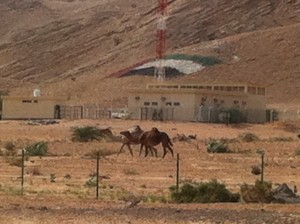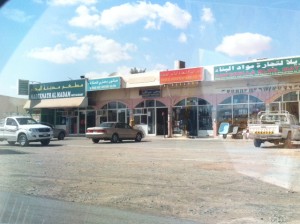Everyone who does a road trip of any significance knows … if at all possible, you want to return by a route different than the one you took for the first half.
Not a lot longer, but a little longer is OK … because you don’t want to see the same stuff twice. Obviously.
What that meant for us, after our drive from Abu Dhabi to Fujairah two days before, was … a journey down the center of the UAE, about halfway between the Gulf and the Indian Ocean, through a part of the country probably not often seen by those who live along the two shores.
At the hotel, the Meridien, in Fujairah, both guys working the valet service were insistent on how we should return to Abu Dhabi — by taking the exact route we had driven two days before.
As is often the case here, instead of naming highways by their number, they gave me direction pegged to landmarks.
“Go to Dibba, and when you see the second roundabout, take the first right at the cement factory …”
In towns here, it’s more like, “go to Khalidiya Mall, and look for the Abu Dhabi National Bank across from the McDonald’s …”
The suggestion being that this country, anyway, is not particularly comfortable with maps. But I digress.
So, we retraced our path, at first, by returning to Dibba — which is far more impressive to see when coming from the east, lined at the foot of the mountains going north.
That probably was Dibba Al Hisn, ruled by Sharjah, as opposed to Dibba Al Fujairah, which we drove through each way. And there is a third Dibba, Dibba Al Baya, which is territory of the nation of Oman — basically one city under three jurisdictions, which is just crazy, but the east coast of the UAE/Oman is a hodge-podge of enclaves and exclaves, including one that has an Emirati core surrounded by a donut of Oman surrounded by more of the UAE. No, really.
We soon came to a place where Google maps, as well as the valets at the hotel, said we should stay on the E87 — by taking the right at the cement factory — which would take us west to Ras Al Khaimah and on down toward Abu Dhabi on coastal roads.
Been there. Done that. And we might hit traffic bottlenecks in Dubai and Sharjah.
Instead we continued straight on something called the E89 highway, on my UAE fold-up map, but described only as the “Dibba-Masafi Road” on Google maps.
We almost immediately began a climb into the mountains. We saw the occasional farm on either side, and the road — two lanes on each side — wound along, with more than a few trucks in the slow lane.
It was impressive scenery, rather like the Chocolate Mountains in the Mojave desert of Southern California, so-named because of the light-brown color.
Then we reached Masafi, a mountain town known to me at that point for two things:
1. The springs that produce Masafi water, the second-most-popular local water in the country, after the Al Ain brand.
2. The sports club that oversaw one of the smaller soccer teams in the country, the second-division Masafi Club.
We also learned that Masafi is much bigger than we thought. It sort of sprawls in three directions, following the lower points of the area, and appears to have 20,000 people or more, as well as a UAE military base.
(Oh, and UAE flags are everywhere, in the country’s outback. Every store, every post … a UAE flag. This is a time of great patriotic sentiment, and National Day is next week. As flag crazy as the U.S. is, I’ve never seen so many flags, per capita, over an extended area.)
Traffic was heavy, particularly because of trucks hauling heavy loads (perhaps cement or crushed rock), going to Dubai and Abu Dhabi. It was easy to get stuck behind those enormous vehicles, and we realized why everyone said to take the coastal road — because the numerous speed bumps and the volume of truck traffic reduced our trip on the E89 to a nerve-racking crawl.
The scenery, at least, was interesting. The commercial part of the town could be seen in strips on each side of the road, the usual small and colorful groceries with grandiose names (“Shining Star Supermarket”), and barbershops and cafeterias and juice places and phone stores, but also bigger commercial spaces with piles of ceramics as well as bright brass or silver-colored pots and pans.
In some other time, we might have stopped.
On through Masafi (which is divided between Fujairah and RAK) and down towards Al Dhaid, on the E88. Trucks still cluttered our route, and what we had budgeted as a four-hour trip looked like it might easily be five.
But after Al Dhaid, where we took the E55 heading south (rather than continuing on to Sharjah city), truck traffic thinned out. Thank goodness.
Oh, and a curiosity: Since leaving Dibba, we had seen goats and our first camels of the trip, but we did not see a single woman. This is the socially conservative part of the country.
We came out of the mountains and picked up speed and racked up the miles. We passed through Al Malailah and then Al Madam, a fairly substantial place even if it doesn’t rise to the level of a wiki entry in English.
The city lends its name to the Madam Plain — a fairly large and flat area that looks as if it supports some sort of agricultural, looking at the tents and small buildings in the distance. We saw signs for goat and camel crossings.
This felt like another world, one in which old ways are still strong, and one that seems to have no affinity for the sea, and a place where the four-lane E55 seemed a federal indulgence for the very few who pass through or live nearby.
We reached the E66, went east for a bit and the farms/ranches gave way to miles and miles of reddish sand dunes, which often spilled onto the freeway despite windbreaks on either side of the road.
By now, we were in Abu Dhabi emirate, where most everything is modern and usually functional. We stopped at a gas station (known as “Adnoc” by its initials), and not only was the toilet pretty much clean, it had toilet paper, paper towels and supports for people in wheel chairs. (Back in Umm Al Qawain, two days before, the bathroom had no paper at all.)
We shifted from the E66 to the E20, perhaps the strangest of all the modern and well-built national roads, because the E20 nearly parallels the E22, maybe 15 miles south — which runs straight from Abu Dhabi to Al Ain.
The E20, nearly empty, runs from Abu Dhabi to the E66, a bit north of Al Ain, seeming to serve nobody except a handful of residents in large homes up on sandy hills. It also has the characteristic Abu Dhabi median planted with palms and bushes, watered by drip hoses and tended by large crews of workers.
And from there, it was a straight run into the capital.
By quickening our pace, the final 70 miles or so, it was four hours from door to door, just as we had planned, and we ended up seeing a part of the country we hadn’t seen before and almost certainly will never see again.
Exactly what you want, from a road trip.
On one tank of gas, which had taken us 760 kilometers — or 472 miles.



0 responses so far ↓
There are no comments yet...Kick things off by filling out the form below.
Leave a Comment